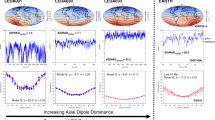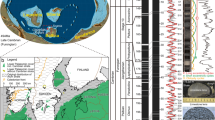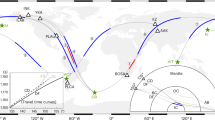Abstract
Recent advances in palaeomagnetic and dating techniques have led to increasingly precise records of the relative intensity of the Earth's past magnetic field at numerous field sites. The compilation and analysis of these records can provide important constraints on changes in global magnetic field intensity and therefore on the Earth's geodynamo itself. A previous compilation for the past 200 kyr integrated 17 marine records into a composite curve1, with the geomagnetic origin of the signal supported by an independent analysis of 10Be production made on different cores2. The persistence of long-term features in the Earth's magnetic intensity or the existence of long-term periodic changes cannot, however, be resolved in this relatively short time span. Here we present the integration of 33 records of relative palaeointensity3,4,5,6,7,8,9,10,11,12,13,14,15,16,17,18,19 into a composite curve spanning the past 800 kyr. We find that the intensity of the Earth's dipole field has experienced large-amplitude variations over this time period with pronounced intensity minima coinciding with known excursions in field direction, reflecting the emergence of non-dipole components. No stable periodicity was found in our composite record and therefore our data set does not support the hypothesis that the Earth's orbital parameters have a direct and strong influence on the geodynamo.
This is a preview of subscription content, access via your institution
Access options
Subscribe to this journal
Receive 51 print issues and online access
$199.00 per year
only $3.90 per issue
Buy this article
- Purchase on Springer Link
- Instant access to full article PDF
Prices may be subject to local taxes which are calculated during checkout



Similar content being viewed by others
References
Guyodo, Y. & Valet, J.-P. Relative variations in geomagnetic intensity from sedimentary records: the past 200,000 years. Earth Planet. Sci. Lett. 143, 23–36 (1996).
Frank, M. et al. A200 kyr record of cosmogenic radionuclide production rate and geomagnetic field intensity from 10Be in globally stacked deep-sea sediments. Earth Planet. Sci. Lett. 149, 121–129 (1997).
Tric, E. et al. Paleointensity of the geomagnetic field for the last 80,000 years. J. Geophys. Res. 97, 9337– 9351 (1992).
Meynadier, L., Valet, J.-P., Weeks, R., Shackleton, N. & Hagee, V. L. Relative geomagnetic intensity of the field during the last 140 ka. Earth Planet. Sci. Lett. 114 , 39–57 (1992).
Tauxe, L. & Wu, G. Normalised remanence in sediments from western equatorial Pacific: relative paleointensity of the geomagnetic field. J. Geophys. Res. 95, 12337– 12350 (1990).
Tauxe, L. & Shackleton, N. J. Relative paleointensity records from the Ontong-Java Plateau. Geophys. J. Int. 117, 769–782 (1994).
Yamazaki, T. & Ioka, N. Long-term secular variation of the geomagnetic field during the last 200 k.y. recorded in sediment cores from the western equatorial Pacific. Earth. Planet. Sci. Lett. 128, 527–544 ( 1994).
Lehman, B. et al. Relative changes of the geomagnetic field intensity during the last 280 kyear from piston cores in the Acores area. Phys. Earth Planet. Inter. 93, 269–284 (1996).
Schneider, D. A. Late Pleistocene and Holocene geomagnetic intensity variations recorded in Sulu Sea sediments. Eos (suppl.) 75, S119 (1994).
Stoner, J. S., Channell, J. E. T. & Hillaire-Marcel, C. A200 ka chronostratigraphy for the Labrador Sea: Indirect correlation of the sediment record to SPECMAP. Earth. Planet. Sci. Lett. 159, 165– 181 (1998).
Channell, J. E. T., Hodell, D. A., McManus, J. & Lehman, B. Orbital modulation of the Earth's magnetic field intensity. Nature 394, 464–468 ( 1998).
Valet, J.-P., Meynadier, L., Bassinot, F. & Garnier, F. Relative paleointensity across the last geomagnetic reversal from sediments of the Atlantic, Indian and Pacific Oceans. Geophys. Res. Lett. 21, 485–488 ( 1994).
Schneider, D. A. & Mello, G. A. Ahigh-resolution marine sedimentary record of geomagnetic intensity during the Brunhes Chron. Earth Planet. Sci. Lett. 144, 297– 314 (1996).
Yamazaki, T., Ioka, N. & Eguchi, N. Relative paleointensity of the geomagnetic field during the Brunhes Chron. Earth Planet. Sci. Lett. 136, 525–540 (1995).
Meynadier, L., Valet, J.-P., Bassinot, F., Shackleton, N. & Guyodo, Y. Asymmetrical saw-tooth pattern of the geomagnetic field intensity from equatorial sediments in the Pacific and Indian Oceans. Earth Planet. Sci. Lett. 126, 109–127 (1994).
Meynadier, L. & Valet, J.-P. Relative geomagnetic intensity during the last 4 m.y. from the equatorial Pacific. Proc. ODP Sci. Res. 138, 779–795 (1995).
Meynadier, L., Valet, J.-P., Guyodo, Y. & Richter, C. Saw-toothed variations of relative paleointensity and cumulative viscous remanence: Testing the records and the model. J. Geophys. Res. 103, 7095 –7105 (1998).
Guyodo, Y., Richter, C. & Valet, J.-P. Paleointensity record from the Pleistocene sediments (1.4–0 Ma) off the California Margin. J. Geophys..Res. (in the press).
Kent, D. V. & Opdyke, N. D. Paleomagnetic field intensity recorded in a Brunhes epoch deep-sea sediment core. Nature 266, 156–159 (1977).
Bassinot, F. C. et al. The astronomical theory of climate and the age of the Brunhes-Matuyama magnetic reversal. Earth Planet. Sci. Lett. 126, 91–108 (1994).
. Martinson, D. G. et al. Age dating and the orbital theory of the Ice Ages: development of a high-resolution 0 to 300,000-year chronostratigraphy. Quat. Res. 27, 1–29 ( 1987).
Merill, R. T., Mc Elhinny, M. W. & McFadden, P. L. (eds The Magnetic Field of the Earth (Int. Geophysics Ser., Academic, London, (1998).
Valet, J.-P. & Meynadier, L. Geomagnetic field intensity and reversals during the past four million years. Nature 366, 91–95 (1993).
Merill, R. T. & McFadden, P. L. Geomagnetic stability: Reversal events and excursions. Earth Planet. Sci. Lett. 121 , 57–69 (1994).
Langereis, C. G., Dekkers, M. J., de Lange, G. J., Paterne, M. & van Santvoort, P. J. M. Magnetostratigraphy and astronomical calibration of the last 1.1 Myr from an eastern Mediterranean piston core and dating of short events in the Brunhes. Geophys. J. Int. 129, 75–94 ( 1997).
Quidelleur, X., Gillot, P. Y. & Carlut, J. Link between excursions and paleointensity inferred from abnormal field directions recorded at La Palma around 600 ka. (suppl.) 78, F181 (1997).
Champion, D. E., Lanphere, M. A. & Kuntz, M. A. Evidence for a new geomagnetic reversal from lava flows in Idaho: Discussion of short polarity reversals in the Brunhes and late Matuyama polarity chrons. J. Geophys. Res. 93, 11667–11680 (1988).
Worm, H.-U. Alink between geomagnetic reversals, events and glaciations. Earth Planet. Sci. Lett. 177, 55–67 (1997).
Malkus, W. V. R. Precession of the earth as the cause of geomagnetism. Science 160, 259–264 (1968).
Wollin, G., Ericson, D. B. & Ryan, W. B. F. Magnetism of the earth and climatic changes. Earth Planet. Sci. Lett. 12, 171–183 (1971).
Creer, K. M., Thouveny, N. & Blunk, I. Climatic and geomagnetic influences on the Lac du Bouchet paleomagnetic record through the last 110,000 years. Phys. Earth Planet. Inter. 64, 314–341 (1990).
Vanyo, J. P. Ageodynamo powered by luni-solar precession. Geophys. Astrophys. Fluid Dyn. 59, 209–234 ( 1991).
Paillard, D., Labeyrie, L. & Yiou, P. Macintosh program performs time-series analysis. Eos 77, 379 (1996).
Acknowledgements
We thank J. E. T. Channell, C. Laj, L. Meynadier, D. A. Schneider, J. S. Stoner, L. Tauxe and T. Yamazaki for supplying data, and F. C. Bennett for comments. This work was supported by the CNRS-INSU program Intérieur de la Terre. At this University of Florida, Y.G. was supported by a grant awarded to J. E. T. Channell.
Author information
Authors and Affiliations
Corresponding author
Supplementary Information
Rights and permissions
About this article
Cite this article
Guyodo, Y., Valet, JP. Global changes in intensity of the Earth's magnetic field during the past 800 kyr. Nature 399, 249–252 (1999). https://doi.org/10.1038/20420
Received:
Accepted:
Issue Date:
DOI: https://doi.org/10.1038/20420
This article is cited by
-
Intermittent non-axial dipolar-field dominance of twin Laschamp excursions
Communications Earth & Environment (2022)
-
A full sequence of the Matuyama–Brunhes geomagnetic reversal in the Chiba composite section, Central Japan
Progress in Earth and Planetary Science (2020)
-
A centennial-resolution terrestrial climatostratigraphy and Matuyama–Brunhes transition record from a loess sequence in China
Progress in Earth and Planetary Science (2020)
-
Dynamics of orbital boost maneuver of low Earth orbit satellites by electrodynamic tethers
Aerospace Systems (2020)
-
Wavelet-based verification of a relative paleointensity record from the North Pacific
Earth, Planets and Space (2019)
Comments
By submitting a comment you agree to abide by our Terms and Community Guidelines. If you find something abusive or that does not comply with our terms or guidelines please flag it as inappropriate.



